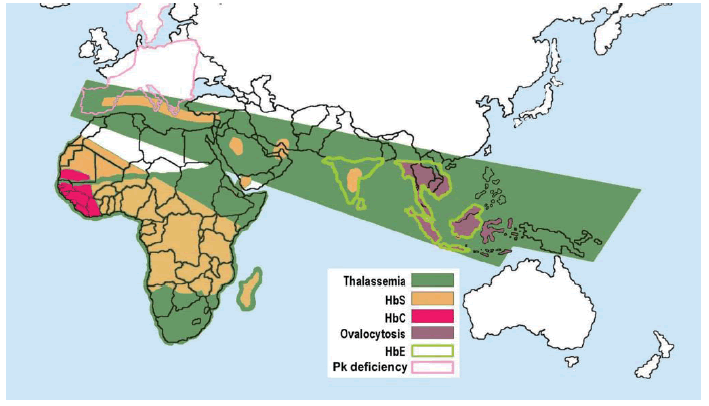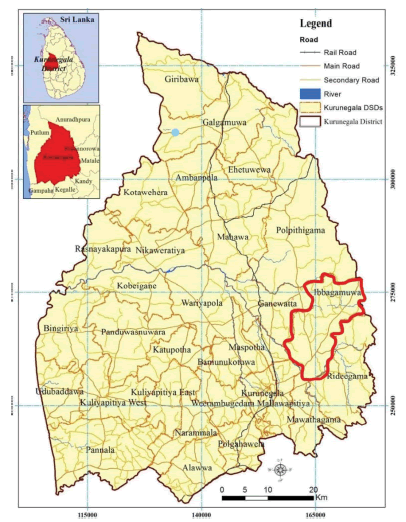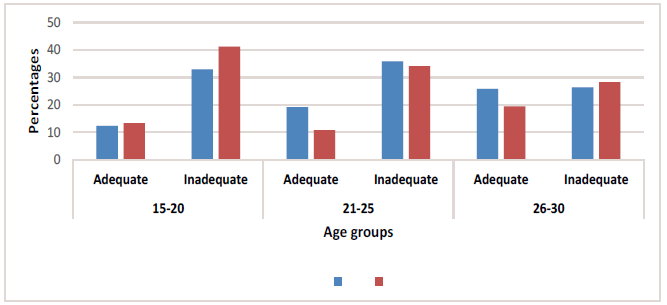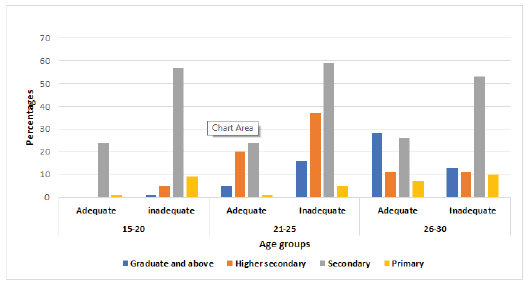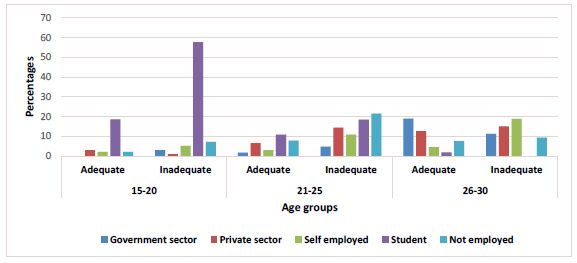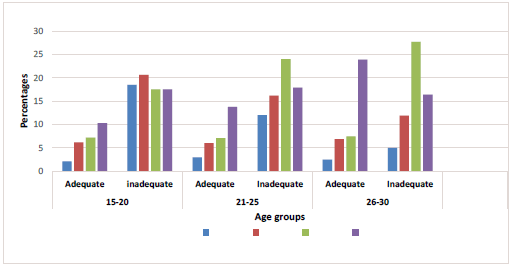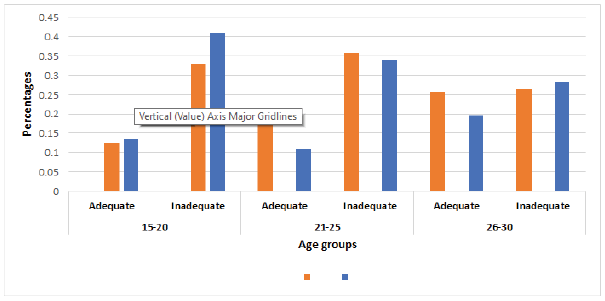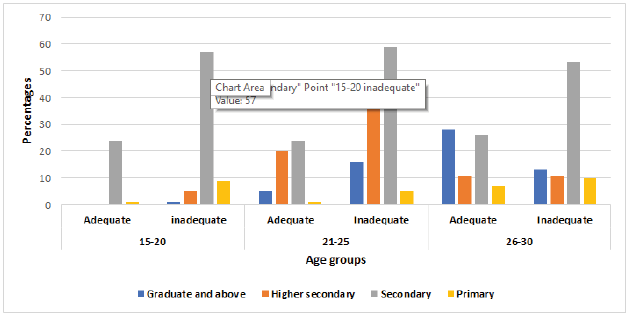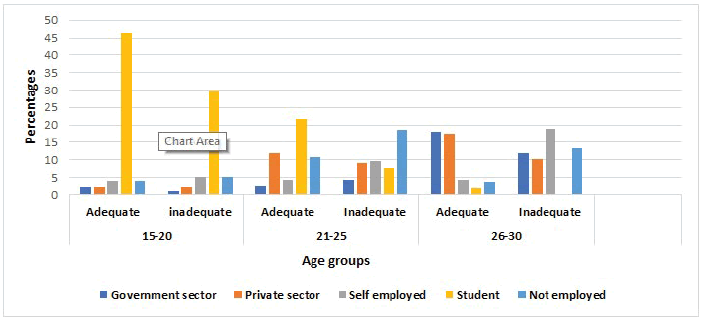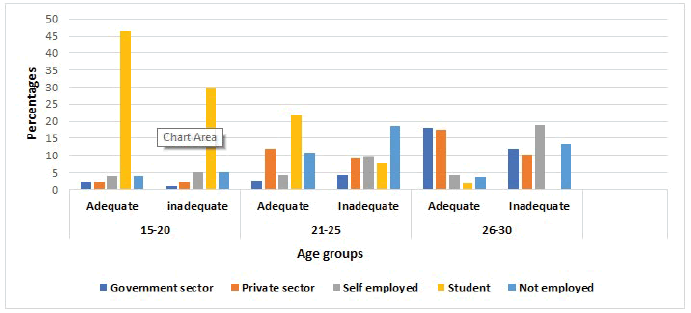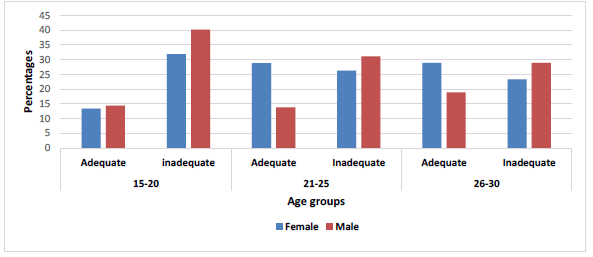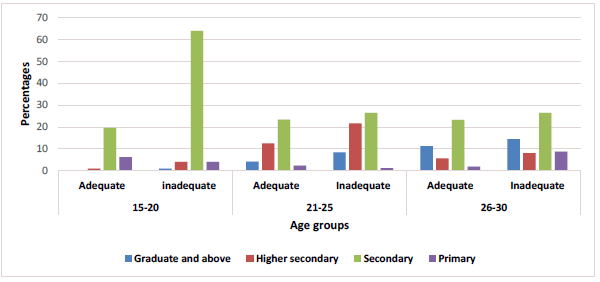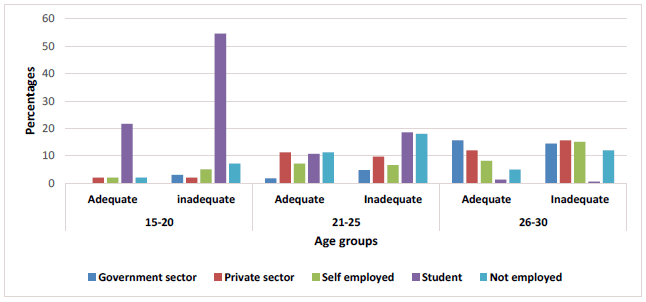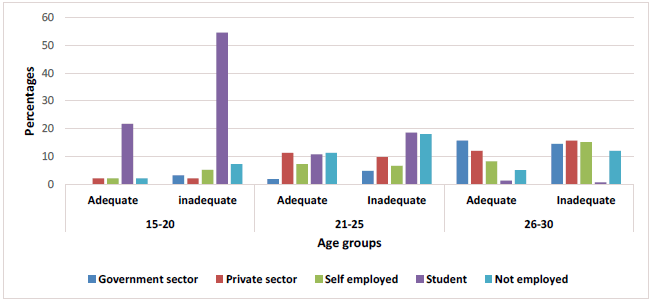Research - International Journal of Medical Research & Health Sciences ( 2022) Volume 11, Issue 8
Knowledge, Attitudes and Practices Towards the Thalassemia Among Young Population in Ibbagamuwa Divisional Secretariat, Kurunegala; Sri Lanka
B.G. K. P. Nandarathna1* and H. R. D. Peiris22Department of Basic Sciences, Faculty of Dental Sciences, University of Peradeniya, Sri Lanka
B.G. K. P. Nandarathna, Department of Medical Laboratory Science, Faculty of Allied Health Sciences, University of Peradeniya, Sri Lanka, Email: kanishkanandarathna123@gmail.com
Received: 08-Aug-2022, Manuscript No. ijmrhs-22- 71422; Accepted Date: Aug 30, 2022 ; Editor assigned: 09-Aug-2022, Pre QC No. ijmrhs-22- 71422 (PQ); Reviewed: 24-Aug-2022, QC No. ijmrhs-22- 71422 (Q); Revised: 29-Aug-2022, Manuscript No. ijmrhs-22- 71422 (R); Published: 31-Aug-2022
Abstract
Background: Thalassemia is an inherited disease and it is encountered in every population in the world. The most common single-gene disorder in Sri Lanka is thalassemia. Most developing countries lack the necessary resources and expertise to provide thalassemia treatment, meanwhile, they cannot bear the cost of treatments, Sri Lanka being a resource-constrained country, prevention is the best option for thalassemia. Hence, enhancing knowledge, attitudes and, practices toward thalassemia is very essential. Objectives: The objective of the study is to evaluate the level of knowledge, attitudes, and practices toward thalassemia among the young population in Ibbagamuwa divisional secretariat, Kurunegala, Sri Lanka. Methods: This study is a cross-sectional, questionnaire-based study and was conducted for 9 months from April to December 2021 using randomly selected participants from the young population in the Ibbagamuwa divisional secretariat, Kurunegala, Sri Lanka. Data collection was conducted through a self administered questionnaire and all statistical analyses were conducted using Statistical Package for Social Sciences (SPSS 25.0). Results: About 34.76% of the study population had adequate knowledge; 46% had an adequate level of positive attitude and 39% had an adequate level of good practice about thalassemia. Frequencies and percentages of correct responses given for knowledge, attitudes, and practices-based questions of thalassemia by different demographic categories of different age groups were also obtained. Conclusions: It was seen in our study that there is an inadequate level of knowledge, attitudes, and practices toward thalassemia among the young population in the Ibbagamuwa divisional secretariat, Kurunegala, Sri Lanka
Keywords
Thalassemia, Knowledge, Attitudes, Practices, Sri Lanka
Introduction
Thalassemia is a heterogeneous group of inherited diseases, and it occurs due to defects in the synthesis of hemoglobin. The blood of a normal adult consists of three types of hemoglobin known as hemoglobin A, hemoglobin A2 and, Hemoglobin F. Hemoglobin A comprises 95% or more of the total adult hemoglobin and it consists of two alpha and beta globin chains each. Patients with thalassemia show either a decreased rate of formation or an absence of production of the polypeptide chains [1,2].
According to the clinical manifestation, thalassemia can be classified as thalassemia major, thalassemia intermediate, and thalassemia minor. The thalassemia major patients require regular blood transfusion within 2 weeks to 5 weeks regularly to maintain a target hemoglobin level of 9 g/dl to 10.5 g/dl and iron chelation therapy for treating iron overload. Hence, this type of thalassemia is known as transfusion-dependent thalassemia. In some thalassemia major cases such as α0 thalassemia, patients usually die in utero or soon after birth. Patients with thalassemia intermediate are known as non-transfusion dependents because they do not require regular blood transfusions but only need them occasionally. Their symptoms are mild to moderate anemia with equal or above 7.5 g/dl hemoglobin level. Thalassemia minor individuals are usually asymptomatic and have minor hematological abnormalities [3,4]. However, they act as carriers. When both parents are thalassemia carriers, their child has a 25% probability of becoming a thalassemia major patient and a 50% probability of becoming a thalassemia minor (carrier) patient [5]. Therefore, individuals who are at risk of having a thalassemia major child should know their carrier status before giving birth to a child.
Thalassemia is encountered in every population in the world. However, it is highly prevalent in South East Asia, the Indian subcontinent, Mediterranean, and Middle East countries. Altogether, these areas are known as the “World Thalassemia Belt” [6].
Hemoglobin disorders are a significant health problem in most countries in the world (71% of 229 countries). Of the pregnant women worldwide, 7% are affected by beta and alpha zero thalassemias or any other hemoglobinopathy and over 1% of couples are at risk of having a child with a hemoglobin disorder. Over 330 000 childbirths per annum are affected by hemoglobin disorders and 17% of them are thalassemia [7]. As a south Asian country, Sri Lanka is also in the tropical thalassemia belt [8]. The most common single-gene disorder prevalent in Sri Lanka is thalassemia [9]. There are approximately 2000 severe thalassemia patients in Sri Lanka. In addition, nearly 80 patients are born annually and many of these births occur in the North Western and North Central Province [9-11]. The highest number of thalassemia cases in Sri Lanka are reported in the Kurunegala district [12]. Nine hundred and thirty patients are registered in the National thalassemia Center and among them, 580 patients live in the Kurunegala district. The highest number of patients in the Kurunegala district is reported in the divisional secretariat of Ibbagamuwa (Information gathered from National Thalassemia Center, Kurunegala). Therefore, it is important to investigate the possible reasons for the higher prevalence of thalassemia in the Ibbagamuwa divisional secretariat to control the disease. This is the main reason for selecting the Ibbagamuwa area for the present study. We strongly believe that this study is very timely and the results of it will greatly help the National thalassemia Center and medical experts to find better and more effective solutions to manage the prevalence of thalassemia in the Ibbagamuwa area and the whole Kurunegala district for that matter.
Thalassemia patients can be identified before two years of age. Most of them require lifetime treatment from the date of recognition [4]. Hematopoietic stem cell transplantation is the only cure for thalassemia but it does not apply to all thalassemia patients. In addition, it is very costly and carries a significant risk of morbidity and mortality [6]. Meanwhile, most developing countries lack the necessary resources and expertise to provide thalassemia treatment and they cannot bear the cost of treatments. In Sri Lanka, thalassemia patients consume 7.5% of the national health budget per annum for treatments [9]. Therefore, prevention is the best option for controlling thalassemia. Different countries use different methods, such as enhancing the awareness of the general population, premarital screening, genetic counseling, and prenatal diagnosis to prevent and control thalassemia [13]. Some countries successfully control thalassemia by using these prevention methods. For example, Cyprus reduced the incidence of thalassemiaaffected babies by over 95% within 10 years using a comprehensive screening program. Greece and Italy also used a similar program to reduce the incidence of affected homozygotes by over 50% [14]. Nevertheless, these prevention strategies also have barriers such as lack of awareness of consanguineous marriages, ignorance or reluctant to undergo premarital and antenatal screening, reluctant to terminate the pregnancy after diagnosing, avoiding genetic testing because of financial constraints, emotional distress, and fear of social stigma, etc [15].
The existing thalassemia prevention programs in the world, seem not to be enough to prevent thalassemia. For example in Pakistan, although premarital screening had been conducted for over a decade, only very few couples had better awareness, and even people who had the awareness did not go for screening due to the high cost of the investigation. Even after the premarital screening, people do not go for a better solution due to religious, ethical, and cultural issues [16]. It is reported that the best way to control thalassemia is to improve knowledge and make people aware of the disease [17]. Hence educating the general population, changing their attitudes towards thalassemia, and increasing better practices of thalassemia is very essential.
The aims and objectives of the present study were to investigate the level of knowledge, attitudes, and practices toward Thalassemia among the young population in the Ibbagamuwa divisional secretariat, Kurunegala, Sri Lanka (Figure 1 and 2).
Methods
This study is a cross-sectional, questionnaire-based study and was conducted for 9 months from April to December 2021 using randomly selected participants from the young population in Ibbagamuwa divisional secretariat, Kurunegala district, North Western Province, Sri Lanka. Young people are defined to be between 15 years to 29 years old by the European Union [18]. Thus, the 15 age to 30 age group was selected in the present study. The study was approved by the Ethical Review Committee of the Faculty of Allied Health Sciences, University of Peradeniya, Sri Lanka (AHSERC-2021-102).
The estimated sample size was 384 for absolute precision of 5%, 423 subjects were taken, including 10% of nonrespondents. The calculated sample size was collected from different Grama Sewa divisions proportionally to the number of registered voters in each of them. Furthermore, the number of participants according to gender and race was calculated and the participants have collected accordingly. Every other person from the voters’ register of each Grama Sewa division was selected randomly
Young people (15 age to 30 age group) who do not live in Ibbagamuwa divisional secretariat at present and, who has mental illnesses were excluded from the study.
A standard questionnaire was developed, based on a thorough review of the literature to assess the level of knowledge, attitudes, and practices towards thalassemia among the young population in Ibbagamuwa divisional secretariat [15,19,20].
The original version of the questionnaire was written in English, and translated into Sinhala and Tamil. The questionnaire consists of 4 parts: parts A, B, C, and D. Part A of the questionnaire was designed to obtain demographic information such as age group, gender, ethnicity, religion, marital state, level of education, employment status, and average household income. In part B, 18 questions were designed to assess the knowledge about thalassemia. Part C consists of 8 questions that were designed to obtain the attitudes of participants toward thalassemia. Part D contains 4 questions and was designed to determine the practices toward thalassemia.
The questionnaire was pre-tested using 20 participants to ensure its validity of the questionnaire. It was modified according to the responses of a pre-test. Data collected from these 20 candidates were not included in the final research.
Permission was obtained from Grama Niladari of relevant villages and public health inspectors before conducting the research. Randomly selected 423 young participants in the Ibbagamuwa divisional secretariat by the principal investigator were provided with an information sheet, consent form/assent form at the beginning. They were included in the study after obtaining their informed consent. In addition, the written consent form was obtained from the parents of participants who are below 18 years of age. Data collection was conducted following all Covid-19 health guidelines within two months in October and November 2021.
Data was entered in MS excel and analyzed using SPSS version 25. Distribution of different age groups, gender distribution, religion, ethnic group distribution, marital status, education level, and average monthly household income among different age groups was calculated and presented as percentages. The differences in the knowledge, attitudes, and practices toward thalassemia among different age groups, educational levels, employment status, income levels, and between genders, were analyzed using the nonparametric Kruskal Wallis test and Mann-Whitney U test.
A correct response to knowledge, attitudes, and the practice-based question is given a score of one, and an incorrect one is scored as zero. Therefore, the total possible score for knowledge-based questions ranges from 0-18, with higher scores indicating better knowledge. A score above 10 out of 18 or 55.5% is considered as having adequate knowledge and a score of 10 and below is taken as having inadequate knowledge [21]. Regarding attitudes-based questions, the total possible score ranges from 0-8, with higher scores indicating an adequate level of positive attitudes. A score above 5 or 62.5% is considered as having an adequate level of positive attitudes and scores of 5 and below were taken as having an inadequate level of positive attitudes [21]. Furthermore, the total possible score for practice-based questions is between 0-4, with higher scores indicating an adequate level of good practice [21].
Results
Out of the total sample of 423 participants, 167 belonged to the 21 age to 25 age group, and 159 and 97 belonged to the 26 age to 30 and 15 age to 20 age groups, respectively. In addition, the majority of participants were females (51.8%); 90.5% were Sinhalese and 89.6% were Buddhist. Over two-thirds (67.1%) of the participants were unmarried. The level of education of the participants ranged from primary to graduate and above. Furthermore, 34.8% of them had an education more than secondary. Half of the participants (50.1%) were employees while 29.8% were still students. In addition, 34% of them had an average household income of more than Rs.40, 000.
Knowledge, attitudes, and practice scores towards thalassemia of the total study population are tabulated in Table 1. The mean score of knowledge in the present study was 9.36 ± 3.5. Only 147 (34.76%) participants had adequate knowledge about thalassemia with a score of >10. On the other hand, the mean score of attitudes in the total population was 4.88 ± 1.97 and only 195 (46%) participants had an adequate level of positive attitudes about thalassemia with a score of >5. When considering practices in the present study, the mean score of the participants was 1.4 ± 1.03. In addition, only 165 (39%) participants had an adequate level of good practices about thalassemia and had a score of >2 in the present study (Table 1).
| Knowledge (18 questions) | Number (n) | Percentage |
|---|---|---|
| Adequate (Score >10 or 55.5%) | 147 | 34.76% |
| Inadequate (Score ≤ 10 or 55.5%) | 276 | 65.24% |
| Attitudes (8 questions) | Number (n) | Percentage |
| Adequate (Score >5 or 62.5%) | 195 | 46% |
| Inadequate (Score ≤ 5 or 62.5%) | 228 | 53.90% |
| Practices (4 questions) | Number (n) | Percentage |
| Adequate (Score ≥ 2 or 50%) | 165 | 39% |
| Inadequate (Score <2 or 50%) | 258 | 61% |
The difference in the knowledge scores towards thalassemia according to gender, education level, employment status, and average household income level among different age groups was charted and presented in Figures 3-6. Accordingly, female participants had better knowledge of thalassemia than males.
When considering the knowledge of thalassemia among individuals with different levels of education, especially in the 26 age to 30 age group, graduates and above and higher secondary level showed better knowledge when compare with other education levels (Figure 4).
Meanwhile, in the 26 age to 30 age group, the government sector employers and students had better knowledge of thalassemia in comparison with private sector employers and self-employed individuals.
A similar trend was observed among individuals with different average household income levels where individuals with higher income in the 26 age to 30 age group showed better knowledge in comparison with lower income groups.
However, overall knowledge about thalassemia was poor and inadequate across genders’ levels of education, employment, and household income. In addition, differences showed in the knowledge about thalassemia among the above categories were not statistically significant.
The differences in the attitude scores towards thalassemia according to gender, education level, employment status, and average household income level among different age groups were charted and shown in Figures 7-10. Similar to the result seen in the knowledge, female participants showed better attitudes towards thalassemia than males.
In addition, participants with graduate and above and higher secondary education showed better attitudes (Figure 8). Furthermore, government employers, private sector employers with good household incomes, and students showed better attitudes towards thalassemia in comparison with self-employed and not employed individuals (Figure 9). However, attitudes towards thalassemia were poor and inadequate.
The differences observed in attitudes towards thalassemia among the above categories were not statistically significant.
The differences in practice scores of thalassemia according to gender, education level, employment status, and household income level among different age groups are shown in Figures 11-14. Females showed better practices towards thalassemia than males.
Individuals with more than Rs. 40,000 average household income of 20 age to 25 age groups and 26 age to 30 age groups showed better practices than others. However, both genders, individuals of all levels of education, and all employment and household income levels categories showed poor and inadequate practices towards thalassemia and none of the age groups achieved a minimum of 50% of adequate practice level.
Discussion
This study was carried out to determine the knowledge, attitudes, and practices toward thalassemia among the young population in the Ibbagamuwa divisional secretariat, Kurunegala, Sri Lanka to identify the gaps related to thalassemia awareness. The participants were selected by considering ethnic group and religious group distribution in the study area. However, some religious and ethnic groups have inconspicuously low numbers and therefore did not consider for analysis. The possible reasons for continuously higher thalassemia cases found in the area over the past years are well understood from the results of the present study.
The results demonstrated that only 34.76% of participants from the whole study population obtained an adequate score for the knowledge-based questions. It is critically low when compared to similar studies done in other thalassemia-prevalent countries such as Malaysia (~87%), Italy (85%), Bahrain (65%), and Saudi Arabia (48%) [13,22-24]. Meanwhile, there are other studies done in several parts of the world which had shown poor knowledge levels as well. For example, a study conducted by Gafoor et al. on the awareness regarding thalassemia in the general population of Rahim Yar Khan, Pakistan, noted that only 26% of participants had an average to a good level of awareness [25]. A similar study conducted by Hossain et al. in 2020 on the knowledge and misperceptions about thalassemia among college students in Bangladesh revealed that only 33% of the participants have even heard about thalassemia [6]. Furthermore, research conducted by Kukreja on the awareness of thalassemia among rural folk in Panang, Malaysia, showed a poor level of knowledge and out of the total respondents, only 46.4% have heard about thalassemia. The study further confirmed that although they have heard about thalassemia, their knowledge of thalassemia was comparatively poor [26]. The lack of knowledge and awareness about thalassemia in an area with high thalassemia prevalence may have a bad effect on the management and prevention of the disease. A low level of knowledge on thalassemia in the community makes life more difficult for both thalassemia patients, and carriers causing several socio-cultural problems. Although the National Thalassemia Centre in Kurunegala regularly conducts awareness programs to improve thalassemia awareness among the general population and charge-free thalassemia carrier identification program, such efforts seem to be insufficient and ineffective in enhancing the knowledge of thalassemia in the Ibbagamuwa Divisional Secretariat.
Positive attitudes in society towards thalassemia patients are essential. It is reported that thalassemia patients suffer from various social problems such as instances of school dropout, family conflict, decreasing social interaction, etc. [27]. On the other hand, good knowledge about thalassemia has an impact on better attitudes towards the disease as well [28]. Poor knowledge about thalassemia observed in participants is well evident by the poor attitude towards thalassemia noticed in the present study. Only 46% of the participants were able to score adequately for the attitudes-based questions. Similar findings were observed in a study conducted by Hossain et al. in 2020 among college students in Bangladesh. Accordingly, the low level of knowledge about Thalassemia among the participants had been reflected by the fact that only 33% of respondents had heard about thalassemia and 40% of students showed negative attitudes toward being a friend of thalassemia patients while ~39% had negative attitudes for donating blood for thalassemia patients [6]. In contradiction to the present study, certain studies show better attitudes with a poor level of knowledge. For example, a study conducted in Bangladesh by Alam et al. in 2020 revealed that of the participants who have heard about thalassemia only 37.7% had adequate knowledge about the disease. Despite this poor level of knowledge and awareness participants showed positive attitudes towards thalassemia with 68% of participants agreeing to do premarital screening and 85.5% having positive attitudes towards donating blood to transfusion-dependent thalassemia patients [20]. Another study which was conducted by Wong et al in 2011 recognized very positive attitudes towards screening for thalassemia although they had a mean knowledge score of 11.85 out of 21 which was considered a poor level of knowledge [13]. On other hand, overall poor attitudes toward better knowledge were recognized in many types of research worldwide. It is reported that poor literacy is one of the main problems in Pakistan and it affects the positive attitudes of parents of thalassemic children [16]. Another study which was conducted by Haque in 2015 to evaluate the level of awareness towards thalassemia among future health care providers revealed poor attitudes spite having better knowledge about thalassemia [29].
Maintaining better practices on thalassemia helps prevent thalassemia and is useful in the treatment process. For example, premarital screening is the most important practice which helps thalassemia prevention [30]. Furthermore, donating blood for thalassemia patients is useful in the treatment process. Having better practices toward thalassemia is very much essential for the present study area of the country to prevent the disease and improve the quality of life of thalassemia patients. In the present study, 39% of the participants showed an adequate level of good practice while 61% showed an inadequate level of practice towards thalassemia. The inadequate level of practice had been recognized in several other studies done in different parts of the world [16,21,28]. In finding the reasons for poor practices, religious beliefs have affected certain practices such as thalassemia screening programs [21]. Furthermore, the lack of awareness about the nature of Thalassemia and the cultural and religious influence also seems to have an impact on practices towards thalassemia [28]. Having a low level of knowledge, attitudes, and practices is a dangerous combination that can be impaired thalassemia prevention and may lead to an increase in the incidence of thalassemia. Meanwhile, certain countries have already taken action to make necessary legislation. For example, a writ petition has been submitted to the High Court of Bangladesh to make premarital screening mandatory in 2018 [20]. Moreover, pre-marital screening was announced as compulsory in Turkey [31]. The results of the mandatory pre-marital screening test are required for the formal process of issuing a marriage certificate in Jordan [30]. Similarly, it is suggested that Sri Lanka should also give value and reason to pre-marital screening to increase better practices towards thalassemia. The National Thalassemia Centre performs screening for thalassemia in the early stages of life in the Ibbagamuwa divisional secretariat. In addition, Sri Lanka conducts a national program to screen for thalassemia from 2005-2006. The goal is to reduce new births of children with thalassemia. Under this national program, primary screening campaigns are conducted in schools, factories, technical colleges, and universities in parallel with the public education program [12]. It is noted that school-based carrier screening is effective and gives advantageous results [13]. Moreover, the frequency of testing should be increased to obtain the maximum benefit in Sri Lanka. It is interesting to investigate the possible reasons for poor knowledge, attitudes, and practices despite having regular awareness programs in Sri Lanka. The Sri Lankan national thalassemia screening program has not received adequate social publicity which helps to convince the benefits of the program to the population. Social media usage, personnel communication, and print media played a significant role during the campaign in raising awareness of thalassemia in the United Arab Emirates [32]. These strategies are applicable in Sri Lanka as well. Hence, conducting adequate social marketing and identification of social, cultural, and religious issues which can influence the awareness programs are very important when maximizing the effectiveness of the national program.
The results of different demographic factor comparisons among age groups revealed that although not statistically significant female participants have better knowledge, attitudes, and practices towards thalassemia than males across all age groups. Furthermore, females show improved knowledge, attitudes, and practices towards thalassemia with advancing age. Therefore, they seem to pay more attention to the diseases which may affect their children in the future. Females showed better knowledge than males in the study conducted by Al Hajeri and Al Arrayed on public awareness of beta-thalassemia in Bahrain [23]. Furthermore, a study conducted among Indonesian youth by Wahidiyat P.A. et al. recorded better knowledge, attitudes, and practices in female participants than in males. They also commented that females may tend to learn more about hereditary diseases such as thalassemia as they have more responsibility for conceiving and raising a child [33].
The graduate and above education level category of the 26 age to 30 age group was the only category that showed an adequate level of knowledge in comparison with other education levels and age groups. Moreover, the graduate and above category and the higher secondary education category showed better attitudes towards thalassemia than other education levels. This result implies that participants seem to gather knowledge and awareness about thalassemia with the advancement of education. It is also recorded that a lower level of education doesn’t deliver adequate information about thalassemia [26]. A cross-sectional study was done among students of Pharm D, MBBS, and the general population to determine awareness about thalassemia Naveed et al. in 2015 and showed that there is a minimal level of awareness regarding thalassemia in the general population as compared to medical students [34]. Another survey conducted by Qadir and Rizvi in 2018 to evaluate the awareness of thalassemia among post-graduate students concluded that most of the post-graduate students are aware of thalassemia [35]. Nevertheless, in certain situations, participants with better education also did not show an adequate level of knowledge. A study which was conducted by Alkhaldi et al. in 2016 to evaluate knowledge, and attitudes towards mandatory premarital screening among university students in north Jordan revealed that only 58% of students had a clear idea about the goal of mandatory premarital screening. The rest of the students had no clear idea although they had a good education level [30]. In addition, research conducted in Bangladesh to detect knowledge deficiency and misperceptions about thalassemia among college students showed negative attitudes such as reluctance to accept the patient as their friend in an educated community [6]. Furthermore, a study conducted in Pakistan revealed that even educated respondents are ill-informed about thalassemia [23].
It is reported that employment status has a significant relationship with the level of knowledge about thalassemia [20]. In the present study, the government sector employers of the 26 age to 30 age group are the only category that showed adequate knowledge about thalassemia. The government sector, private sector, and students scored better on the attitude-based questions. The students and private sector employers answered satisfactorily on attitude-based questions when compared to knowledge-based questions. A study conducted by Haque and Haque in 2015 revealed that students’ attitudes have become improved with the advancement of age. It is further confirmed by the present study which showed improved attitudes toward thalassemia as age progresses [29]. In addition, both the government sector and the private sector illustrated better practices than other employee groups in the present study. Students can be targeted easily when arranging awareness programs, and it may help to improve their knowledge simultaneously with their attitudes. Participants from the government sector and private sector have more social contacts than other employment categories and it might be a reason for their better practices toward thalassemia.
All the average household income categories in the 15 age to 20 age and 20 age to 25 age groups illustrated a very low level of knowledge. Only the participants of the 26 age to 30 age group with more than Rs. 40,000 average household income had adequate knowledge of thalassemia while the other three income categories scored poorly for knowledge-based questions. In terms of attitudes and practices, in the 15 age to 20 and 20 age to 25 age groups, participants with more than Rs.40, 000 average household income demonstrated better practices when compared to knowledge, while other income categories demonstrated poor scores for all parameters tested. In the 26 age to 30 age group, the number of expected responses by the participant with more than Rs. 40,000 average household income category is high, and adequate knowledge, attitudes, and, practices scores are more than inadequate scores. Moreover, participants with more than Rs. 40,000 in average household income showed a significant difference in their knowledge, attitudes, and, practices scores when compared to other income categories. This revealed that the income of the population has an impact on knowledge, attitudes, and, practices towards thalassemia. The Higher level of awareness was recognized in the higher income categories in previous research as well [13]. People with high income consider their health status better than others, possibly because they have access to more facilities, such as health insurance, necessary investigations, etc. Furthermore, a study has revealed wealth and income as economic determinants of the decision to buy voluntary private health insurance in high-income countries [36]. Therefore, priority can be given to the low-income populations when conducting awareness programs and prevention programs in the study area of the present study. However, the research which was conducted by Pujani M. et al. on the knowledge and attitude towards thalassemia among Indian medical students’ economical classes had no impact on attitudes and knowledge towards thalassemia [37].
Conclusion
The present study shows that the level of knowledge, attitudes, and practices toward thalassemia among the young population in the Ibbagamuwa divisional secretariat, Kurunegala, Sri Lanka is inadequate. The result of this study gives an important message to the National Thalassemia Centre, health planners, policymakers, educators, and various other functionaries about the level of knowledge, attitudes, and, practices towards thalassemia among the young population in the divisional secretariat of Ibbaggamuwa. The present study further suggests that thalassemia prevention efforts in Sri Lanka should be expanded to include compulsory thalassemia screening before marriage in recognized risk areas of the country. Education about thalassemia must be emphasized at a national level in Sri Lanka. Information about the prevention of thalassemia should be integrated into science or health and physical education before 10th grade and it may benefit young individuals who stop their education after the ordinary level. The awareness programs should be conducted broadly in risk areas such as the divisional secretariat of Ibbagamuwa by obtaining the voluntary participation of university students, health care workers, and religious groups. Finally, further research is needed to find the reason for the lack of knowledge, attitudes, and, practices toward thalassemia among the young population in the Ibbagamuwa divisional secretariat and to find the most effective method of awareness.
Declarations
Conflict of Interest
The author declared no potential conflicts of interest with respect to the research, authorship, and/or publication of this article.
Formatting of Funding Sources
This research did not receive any specific grant from funding agencies in the public, commercial, or not-for-profit sectors
References
- Spainhour, Charles B. "Pathology: Necropsy and Gross Pathology." The Role of the Study Director in Nonclinical Studies: Pharmaceuticals, Chemicals, Medical Devices, and Pesticides, 2014, p. 259.
Google Scholar - Dacie, John V., and Shirley M. Lewis. "Practical haematology." Practical haematology, 1995, pp. 609-09.
Google Scholar - Cheng, Kimhaung, et al. “Effect of health education on severe thalassemia prevention and control in communities in Cambodia”, Archives of Public Health, Vol. 76, No. 13, 2018.
Crossref - Mettananda, Sachith. “Management of Thalassaemia”, Sri Lanka Journal of Child Health, Vol. 47, No. 2, 2018, pp. 159–65.
Google Scholar Crossref - Borgna‐Pignatti, Caterina, et al. "Survival and complications in thalassemia." Annals of the New York Academy of Sciences, Vol. 1054, No. 1, 2005, pp. 40-47.
Google Scholar Crossref - Hossain, Mohammad Sorowar, et al. "Lack of knowledge and misperceptions about thalassaemia among college students in Bangladesh: a cross-sectional baseline study." Orphanet journal of rare diseases, Vol. 15, No. 1, 2020, pp. 1-10.
Google Scholar Crossref - Modell, Bernadette, et al. "Epidemiology of haemoglobin disorders in Europe: an overview." Scandinavian journal of clinical and laboratory investigation, Vol. 67, No. 1, 2007, pp. 39-70.
Google Scholar Crossref - Mettananda, Sachith, et al. "Health related quality of life among children with transfusion dependent β-thalassaemia major and haemoglobin E β-thalassaemia in Sri Lanka: a case control study." Health and quality of life outcomes, Vol. 17, No. 1, 2019, pp. 1-13.
Google Scholar Crossref - Sirisena, Nirmala D., and Vajira HW Dissanayake. "Genetics and genomic medicine in Sri Lanka." Molecular Genetics and Genomic Medicine, Vol. 7, No. 6, 2019. p. 744.
Google Scholar Crossref - Premawardhena, A. P., et al. "An islandwide hospital based epidemiological survey of haemoglobinopathies and an assessment of standards of care in 23 centres." Ceylon Medical Journal, Vol 62, No 73, 2017.
Google Scholar - Mettananda, S., and D. G. H. De Silva. "Anaemia in children: are we using the correct prevention strategies?.", 2017.
Google Scholar Crossref - Premawardhana, Anuja P., et al. "A nationwide survey of hospital-based thalassemia patients and standards of care and a preliminary assessment of the national prevention program in Sri Lanka." PloS one, Vol. 14, No. 8, 2019, p. 0220852.
Google Scholar Crossref - Wong, Li P., Elizabeth George, and Jin-Ai MA Tan. "Public perceptions and attitudes toward thalassaemia: Influencing factors in a multi-racial population." BMC Public Health, Vol. 11, No. 1, 2011, pp. 1-9.
Google Scholar Crossref - Turnpenny, Peter, Sian Ellard, and R. Cleaver. "Emery's Elements of Medical Genetics.", 2020.
Google Scholar Crossref - Ebrahim, Sidra, et al. "Knowledge and Beliefs regarding thalassemia in an urban population." Cureus, Vol. 11, No. 7, 2019.
Google Scholar Crossref - Ali, Saima, and Malik F. Saffiullah. "Awareness of parents regarding beta thalassemia major disease." Khyber Medical University Journal, Vol. 7, No. 2, 2015, pp. 72-5.
Google Scholar Crossref - Karimzaei, Tahmineh, et al. "Knowledge, attitude and practice of carrier thalassemia marriage volunteer in prevention of major thalassemia." Global journal of health science, Vol. 7, No. 5, 2015, p. 364.
Google Scholar Crossref - Eurostat, Couette, C., et al. “Being young in Europe today”, 2015 edn, p. 39.
Google Scholar Crossref - Miri-Moghaddam, Ebrahim, et al. "High school knowledge and attitudes towards thalassemia in southeastern Iran." International Journal of Hematology-Oncology and Stem Cell Research, Vol. 8, No. 1, 2014, p. 24.
Google Scholar Crossref - Islam, Md S., et al. "Public Perceptions and Attitudes of Bangladeshi Population towards Thalassemia Prevention: A Nationwide Study.", 2021.
Google Scholar Crossref - Basu, Mausumi. "A study on knowledge, attitude and practice about thalassemia among general population in outpatient department at a Tertiary Care Hospital of Kolkata." Journal of Preventive Medicine and Holistic Health, Vol. 1, No. 1, 2015, pp. 6-13.
Google Scholar Crossref - Armeli, Christina, Steven J. Robbins, and Deborah Eunpu. "Comparing knowledge of β-thalassemia in samples of Italians, Italian-Americans, and non-Italian-Americans." Journal of Genetic Counseling, Vol. 14, No. 5, 2005, pp. 365-76.
Google Scholar Crossref - Al Arrayed, S., and DHCM DHCG. "Public awareness of beta thalassemia in Bahrain." Bahrain Medical Bulletin, Vol. 34, No. 1, 2012, pp. 26-9.
Google Scholar Crossref - Olwi, Duaa I., Leena A. Merdad, and Eman K. Ramadan. "Thalassemia: a prevalent disease yet unknown term among college students in Saudi Arabia." Journal of community genetics, Vol. 9, No. 3, 2018, 277-82.
Google Scholar Crossref - Ghafoor, Muhammad B., et al. "Awareness Regarding Thalassemia in General Population of Rahim Yar Khan, Pakistan." Health Sciences, Vol. 9, No. 6, 2020, pp. 79-84.
Google Scholar - Khoo, Chung L., et al. "Awareness of cervical cancer and HPV vaccination and its affordability among rural folks in Penang Malaysia." Asian Pacific Journal of Cancer Prevention, Vol. 12, No. 6, 2011, pp. 1429-33.
Google Scholar - Roy, Tanuka, and Suhita C. Chatterjee. "The experiences of adolescents with thalassemia in West Bengal, India." Qualitative Health Research, Vol. 17, No. 1, 2007, pp. 85-93.
Google Scholar Crossref - Zaheer, Zafar, et al. "Knowledge, Attitude and practices with relevance to Thalassemia." Journal of Medical Sciences, Vol. 23, No. 2, 2015, pp. 109-12.
Google Scholar - Haque, A. E., et al. "Thalassaemia: Level of awareness among the future health care providers of Malaysia." Journal of Chemical and Pharmaceutical Research, Vol. 7, No. 2, 2015, pp. 896-02.
Google Scholar - Alkhaldi, Sireen M., et al. "Knowledge and attitudes toward mandatory premarital screening among university students in North Jordan." Hemoglobin, Vol. 40, No. 2, 2016, pp. 118-24.
Google Scholar Crossref - Okyay, Ramazan A., et al. "Haemoglobinopathy awareness among young students in Turkey: outcomes of a city-wide survey." PLoS One, Vol. 11, No. 7, 2016, p. 0159816.
Google Scholar Crossref - Zamoum, Khaled. "The use of social marketing campaigns in raising awareness of thalassemia in the uae." Communication Today, Vol. 11, No. 1, 2020, pp. 186-98.
Google Scholar Crossref - Wahidiyat, Pustika Amalia, et al. "Cross-sectional study on knowledge, attitude and practice towards thalassaemia among Indonesian youth." BMJ open, Vol. 11, No. 12, 2021, p. 054736.
Google Scholar Crossref - Naveed, S., et al. "Prevalence and Consequences of PHOBIAS, Survey Based Study in Karachi." Journal of Bioequivalence and Bioavailability, Vol. 7, 2015, pp. 140-43.
Google Scholar Crossref - Qadir, Muhammad Imran, and Maria Rizvi. "Awareness about thalassemia in post graduate students."Malaysian Orthopaedic Journal, Vol. 2, No. 1, 2018, pp. 14-6.
Google Scholar Crossref - Pinilla, Jaime, and Beatriz G. López-Valcárcel. "Income and wealth as determinants of voluntary private health insurance: empirical evidence in Spain, 2008–2014." BMC Public Health, Vol. 20, No. 1, 2020, pp. 1-10.
Google Scholar Crossref - Pujani, Mukta, et al. "Knowledge and attitude among Indian medical students towards thalassemia: a study in Delhi NCR." International Journal of Research in Medical Sciences, Vol. 5, No. 10, 2017, p. 4470.
Google Scholar Crossref

